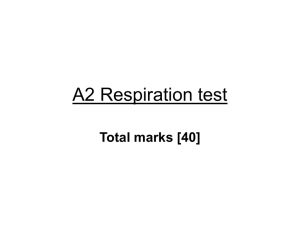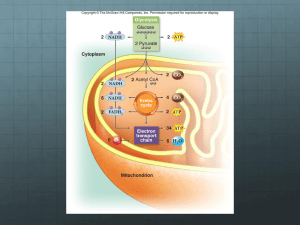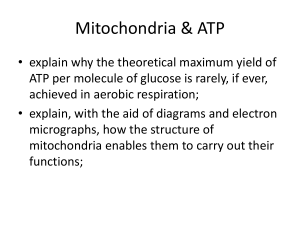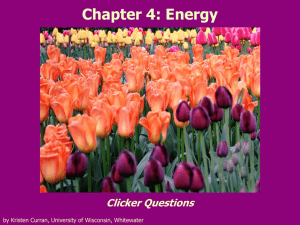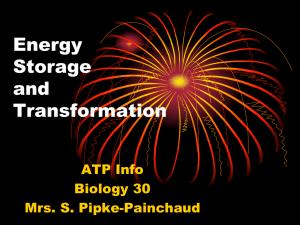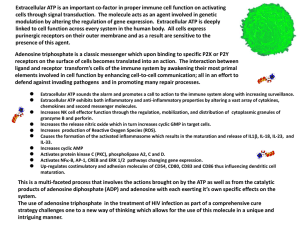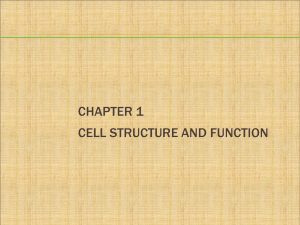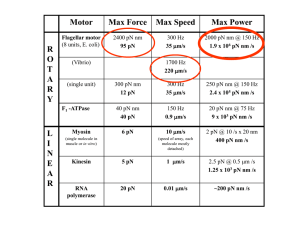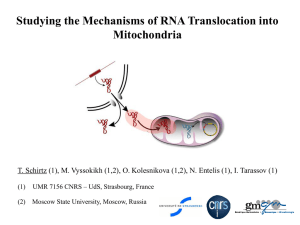Document
advertisement
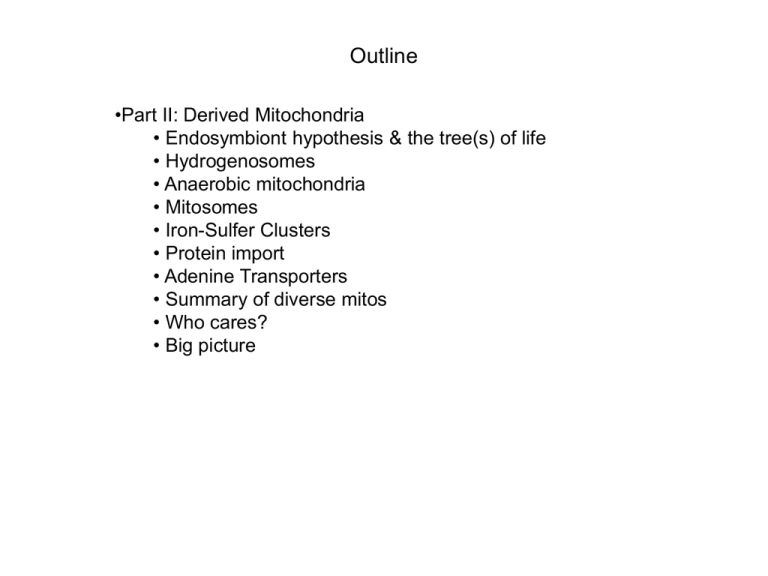
Outline •Part II: Derived Mitochondria • Endosymbiont hypothesis & the tree(s) of life • Hydrogenosomes • Anaerobic mitochondria • Mitosomes • Iron-Sulfer Clusters • Protein import • Adenine Transporters • Summary of diverse mitos • Who cares? • Big picture Endosymbiont hypothesis revisited Endosymbiont hypothesis revisited (Nature, 1998) Rickettsia is the etiological agent of typhus Old eukaryotic tree of life proposing when endosymbiosis took place Anaerobes without canonical mitos Rooted rRNA tree Derived mitochondria MLO= mitochondria like organelles • Harbored by anaerobes and/or parasites Hydrogenosome of Trichomonas vaginalis • Anaerobic parasite of vaginal tract • Common venereal disease • Model organism for hydrogenosomes • Bound by double membranes • No DNA • No cristae • No Krebs Cycle • No electron transport chain • No oxidatative phosphorylation Why hydrogenosome? Dehydrogenase (Hrdy et al., 2004, Nature) Ferredoxin (electron acceptorinstead of ubiquonine) Pyruvate:ferridoxin Oxidoreductase (PFO) Hydrogenase Substrate level phosphorylation • Produce ATP by substrate level phosphorylation • Chemical phosphorylation instead of generation of ATP by proton motive force generated by OxPhos • Oxidation of pyruvate and malate to H2, CO2 and acetate to make ATP • Participation of 2 remnant complex I (1st big complex of respiratory chain) subunits for malate catabolism Anaerobic mitochondria • Anaerobic ciliate Nyctotherus ovalis • Lives in hindgut of cockroaches (!!!) • double membrane organelle • cristae • organellar DNA • Has ΔΨm has shown by Rhodamine 123 and other vital dyes • Subunits of complex I in both organellar and nuclear genomes • Subunits of ccomplex II in nuclear genome • Electron transport? • cV? • Like hydrogenosome, releases H2, CO2, and acetate • Missing link between mito and hyrogenosomes? (Boxama et al., 2005, Nature) Mitosomes Found in the following parasites: Entamoeba histolytica • Anaerobic parasite infecting intestinal tract Microsporidia • Intracellular parasite • Fungi Giardia intestinalis • Anaerobic parasite infecting intestinal tract Mitosomes • Double membrane bound organelles • No DNA • No cristae • No ATP synthesis • So what do they do? Fe-S assembly! Immunogold electron microscopy labeling protein IscU Iron-Sulfur Clusters Important co-factors for ~ 100 proteins in typical eukaryotic cell [2Fe2S] [4Fe4S] Important co-factors in catalysis of redox reactions • Electron transport/transfer • Thiolation Iron-Sulfur containing proteins Lill and Muhlenhoff, 2008, Annu Rev Biochem Iron-sulfur cluster assembly frataxin • Fe2+ doner Scaffold* protein Nfs-Isd11 complex • cysteine desulfurase • S doner * • Nfs ≈ bacterial IscS * ferredoxin • electron doner Lill and Muhlenhoff, 2008, Annu Rev Biochem Iron-sulfer assembly proteins in mitosomes Giardia • localized with specific antobody (Tovar et al., 2003, Nature) Trichomonas • localized with Cterminal tag Microsporidia • localized with specific antibody (Goldberg et al., 2008, Nature) (Sutak et al., 2004, Nature) Iron-Sulfur Synthesis The only essential function of mitochondria • Yeast without mtDNA can grow in fermentable media as ρ mutants • However, interference with Fe-S assembly is lethal in fermentable media since it affects too many other cellular events • Presence in mitosomes and hydrogenosomes of Fe-S assembly proteins supports this notion Conservation of protein import C-terminal tagged G. intestinalis mitosomal proteins expressed in T. vaginalis Conclusion: they share protein import machinery (Dolezal, 2005, PNAS) Protein import Several Protein complexes required for mt protein import Translocase of Outer membrane Mitochondrial IMS Assembly Machinery -Redox mediated import - intraprotein disulfide bridge formation Export and assembly machinery of inner membrane Sorting And Assembly Machinery Carrier Translocase Of Inner Membrane Presequence translocase of inner membrane & Presequence translocase-associated motor Pre-sequence Signal peptides • Usually N-terminal • Postively charged (basic residues His, Lys and Arg) interspersed with hydrophobic residues • Lengths vary between systems • These properties are the basis of programs used to predict mt signal peptides, e.g. MITOPROT and SignalP on Internet C N Protein import Translocase of outer membrane Basic Features: • Presequence and "carrier" (internal signal) initially bind 2 different TOM subunits, but are transferred to the same translocation machinery • TOM20 (binding presequence signal) has domain of negative charge • No ATP required (Chacinska et al., 2009, Cell) Protein import Presequence translocase of inner membrane Basic Features: • ΔΨm needed for initial presequence signal peptide penetration into mt matric • ATP hydrolysis required for pulling rest of protein into matrix • Several heat shock proteins 70 (HSP 70) is believed to work in conjunction • HSP70 consumes ATP HSP (Chacinska et al., 2009, Cell) Adenine Nucleotide Transporters ANT • ATP/ADP antiporter in mitos • exchange b/w cyto and matrix • Estimated that human ortholog traffics 50-60 kg ATP per day! • Gets ATP out of mito and into cytoplasm where it can be used • putative role apoptosis as part of mtPTP (Tsaousis et al., 2008, Nature) • maintain ΔΨm in some ρ mutants Characterization of ANT in the mitosome of the microsporidian E. cuniculi • this one actually takes ATP from cyto and exchanges it for ADP from mito Novel ATP/ADP transporter in mitosome of Entamoeba also reported Summary of derived mitochondria MLOs= mitochondria like organelles Anaerobic Mitochondria (Hydrogenosome) Canonical Mitochondria • Cristae • DNA* • “Powerhouse” • Respiratory Chain • ΔΨm • Fe-S machinery • TOM/TIM Protein Import • ANT → ATP out/ ADP in *not always=petite mutants • Cristae • DNA • Some electron transport complexes • “Powerhouse” • ΔΨm • TOM/TIM Protein Import (most likely) •ANT → ATP out/ ADP in (most likely) Hydrogenosome • “Powerhouse” • Remnant cI of respiratory chain (T.v.) • Fe-S machinery • TOM/TIM Protein Import •ANT → ATP out/ ADP in (most likely) ALL ARE BOUND BY DOUBLE MEMBRANES Mitosome • Fe-S machinery • TOM/TIM Protein Import •ANT → ATP out/ ADP (microsporidia) •No identifiable ANT in Giardia but believed that ATP has to get in somehow • Novel ANT in Entamoeba Summary of derived mitochondria MLOs= mitochondria like organelles MLOs all over tree of life. Evidence of single endosymbiont acquisition Mitochondrial variety even in mammals? • ρ0 mutants in Chinese hamster fibroblast cells • Significant amount of energy requirements satisfied by glycolysis • Limiting glucose only modestly increases respiration • Different cell types with different energy requirements • Muscle and nerve cells have high energy needs • Susceptible to mutations affecting nuclear and mito encoded mito proteins such as Freidreich’s ataxia Cardiac muscle (From Scheffler, Mitochondria) Adrenal cortex Sarcomeres That's nice, but who cares? Who cares about mitochondrial diversity anyway? This guy does: Vamsi Mootha at Harvard Medical School and Massachusetts General Hospital Exploits innate differences in mitochondrial physiology from several cell types to gain insight into human mitochondrial (and pathologies caused by their dysfunction). Case study: using proteomics, bioinformatics, computational strategies (and verified some experimentally) to create a Mitocarta of human mito proteins Complex I of the respiratory chain • Largest of respiratory complexes by far • 45 known subunits in human mitos • Also requires assembly factors for its biogenesis Orthologues of human Mitocarta proteins have telling pattern of occurrence Presence of Mitocarta genes in 500 seq genomes Origin of Mitocarta genes Phylogenetic origin of Mitocarta proteins compared to whole mouse Identification of proteins involved in complex I biogenesis • Using bioinformatics, looked for ABSENCE of 19 complex I candidate genes in the genomes of organisms without this complex • lost 4 times in evolution: • 2x in yeast • 1x in apicomplexans (very reduced mito but still with DNA) • 1x in the mitosome containing clade • Assumption #1: 19 candidates present in bacteria to assemble its complex I • Assumption #2: present in complex I containing eukaryotes where needed and lost in those without Validation of one candidate by RNAi affect on complex I and a clinical case Complex I activity Real time qPCR of targeted candidate mRNA Western with complex I subunit Ab Effect of RNAi on complex I Mutation in C8orf38 ORF causes a defect in complex I activity, resulting in pathologies (ataxia, decreased strength, eventual cardiac arrest) in 2 infant patients Big Picture • In textbooks, mitochondria have been presented as “powerhouses” of the cell based on studies on yeast and metazoans • However, these organelles are far more diverse than that! • Plenty of other roles including: • Apoptosis signaling • Fe-S cluster assembly • Ion homeostasis • This role as a powerhouse does not apply for all mitochondria • Also, it seems that DNA is also dispensable under the right conditions: • Fermentable media • Anaerobic • Parasitism • And if mtDNA is so easy to lose, why is it maintained in canonical mitos? • So far, no amitochondrial organisms reported (Archezoa all have mitosomes) • Double membraned organelles ultimately essential? • Diversity of mitochondria can be elegantly exploited to reveal molecular mechanisms underlying mitochondrial functions What will be on the test? Answers: HH Q1: B HH Q2: D HH Q3: True HH Q4: Mud Lick, Kentucky, USA HH Q5: W HH Q6: (Trick question, leave blank)
